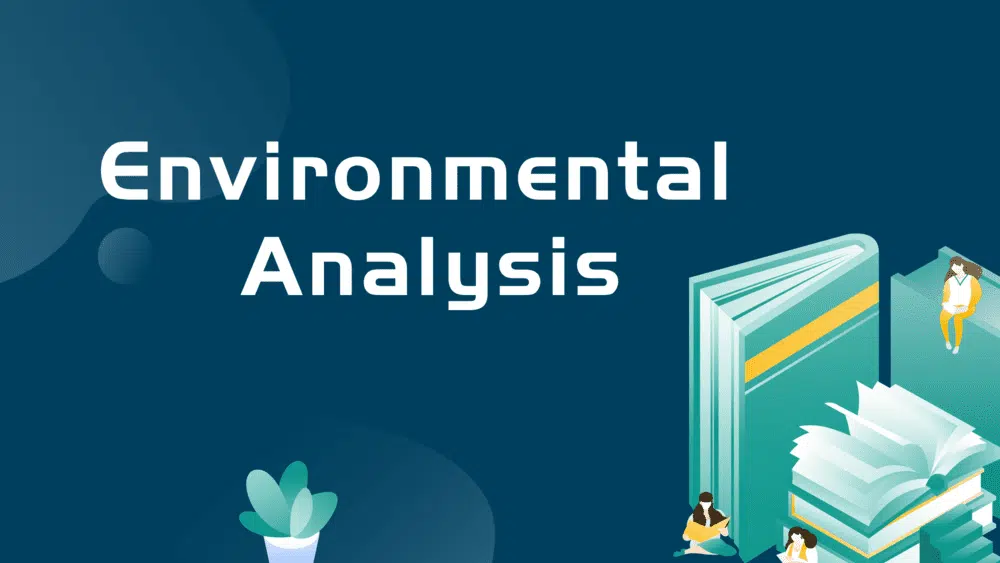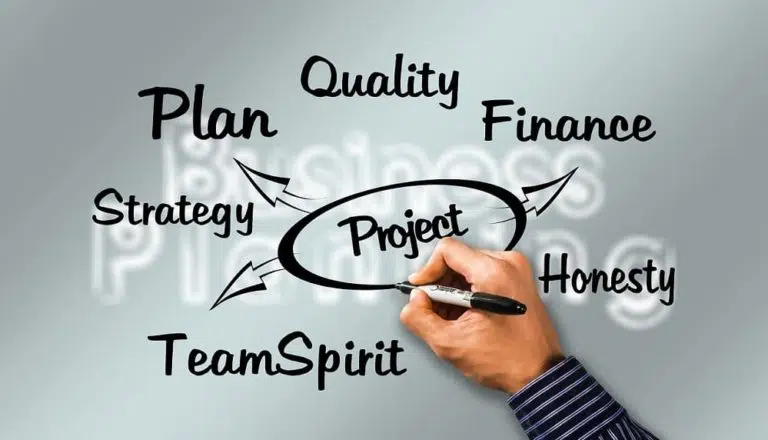Environmental analysis plays a crucial role in determining the success of a business. Companies cannot thrive in isolation and must remain sensitive to the factors that influence their environment. In today’s dynamic market, uncertainty reigns supreme, fueled by fierce competition and globalization.
These environmental elements form an intricate web of interconnectedness known as an ecosystem, encompassing internal and external factors. By conducting an environmental analysis, businesses can understand this ecosystem and use this knowledge to plan effective strategies and manage their organizational portfolios.
What is Environment Analysis?
An environmental analysis can provide businesses with invaluable insights into the various factors that impact their operations. These factors can be positive or negative; businesses must identify and manage them accordingly. Positive factors represent opportunities that should be seized upon, while negative factors pose threats that must be mitigated or eliminated.
For instance, consider the case of a refining business experiencing a drop in crude oil prices. This presents an opportunity to produce products at a lower cost and sell them at a higher profit margin. Conversely, inflation represents a negative factor that increases the cost of production inputs while decreasing the purchasing power of customers.
Businesses that fail to remain sensitive to their environment risk missing out on potentially lucrative opportunities and becoming reactive when threats arise. By conducting an environmental analysis, companies can strike a balance between intuition and evidence-based decision-making, positioning themselves for sustained success in the long run.
The Influence of Competition on Environmental Analysis
Competition is a crucial factor in business that can make or break a company. It catalyzes driving efficiency and innovation, pushing businesses to their limits and compelling them to deliver their best to stay afloat. With the constant threat of competitors lurking around every corner, businesses must be at the top of their game to survive and thrive in this fiercely competitive landscape.
Environmental Analysis Model
There are many models for environmental analysis, such as
- Porter’s Five Forces
- PESTLE Analysis
- SWOT Analysis
1. Porter’s Five Forces
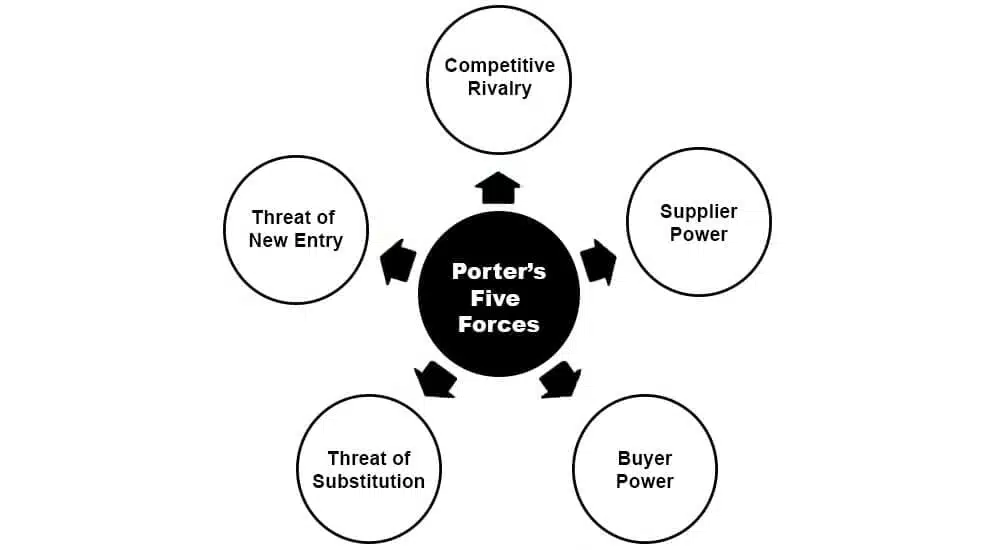
Porter’s Five Forces framework is a powerful tool for analyzing business competitiveness. It was first introduced by the eminent Harvard Business School professor, Michael E. Porter, in his seminal 1979 book, “How Competitive Forces Shape Strategy.”
This groundbreaking framework is designed to identify and evaluate the five key forces that shape competition within an industry, ultimately determining the potential for profitability of businesses operating in that space.
With this invaluable framework in hand, businesses can gain critical insights into the dynamics of their industry and develop effective strategies to stay ahead of the game.
Porter’s five forces are:
#1. The Threat of Substitutes
During environmental analysis, businesses evaluate alternative products or services that could replace their own. If customers find better value in these alternatives, they may switch, causing the business to lose market share.
Therefore, businesses must strive to make their products or services more valuable to customers by offering competitive pricing, high quality, and innovative features.
#2. The Threat of New Entrants
New entrants represent a potential threat to existing businesses, driving them to increase brand awareness and improve their products and customer services to remain competitive. Ignoring new entrants can result in a loss of market share before realizing the threat.
For instance, low-cost carriers like Southwest Airlines and Ryanair broke into the highly competitive American airline industry by developing innovative cost-cutting models.
#3. Buyer’s Bargaining Power
In today’s globalized market, customers are informed and empowered, can compare prices and values, and easily shift loyalty.
To counteract this, businesses must consider loyalty programs, product differentiation (unique features that competitors cannot replicate), and other strategies to retain customers and build brand loyalty.
#4. Supplier’s Bargaining Power
Suppliers are key stakeholders in the business process, and businesses must analyze the supplier market carefully.
While having more suppliers can provide more choices, proprietary or few suppliers can be challenging to replace. Therefore, businesses should choose standardized inputs for multiple suppliers, ensuring continuity and profitability.
#5. Rivalry Among Competition
The industry’s competition level is determined by the number of competitors, their size, and product similarity. Businesses must differentiate their products as much as possible to stay ahead of the competition.
By analyzing Porter’s five forces, businesses can understand their competitive environment and develop effective strategies to increase competitiveness and profitability.
2. PESTLE Analysis
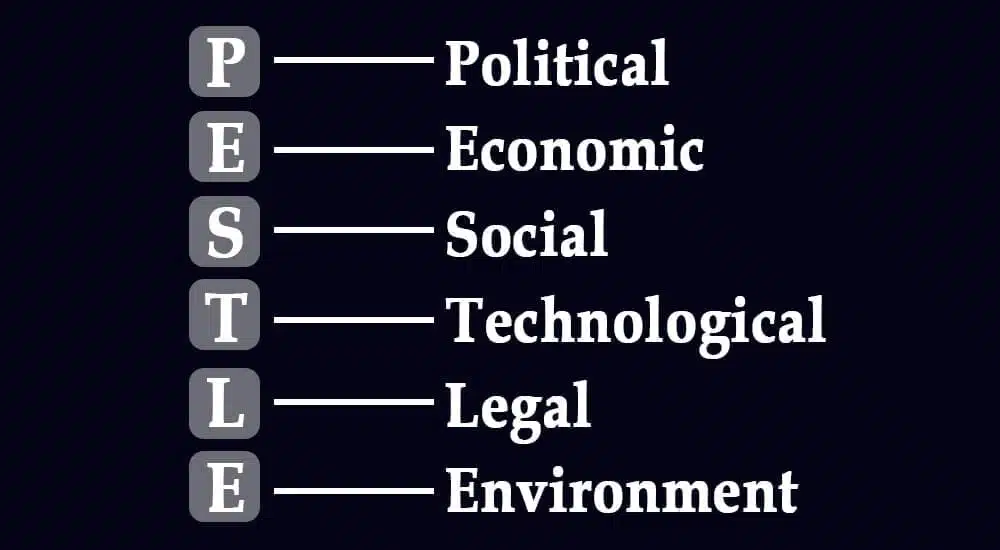
Harvard Business School professor Francis J. Aguilar developed the PESTLE analysis. He first introduced ETPS analysis (Environmental, Technical, Political, and Social) in his book “Scanning the Business Environment” in 1967.
Later, the ETPS analysis model grew and included additional factors, such as Economic, Legal, and Environmental, and became PESTLE analysis. The origin of PESTLE is not documented, but it is popularized in the 1990s.
These factors are coined in the acronym as follows:
#1. Political
Businesses operate in an environment subject to government policies, regulations, and interests. Therefore, businesses should monitor their country’s political environment for potential threats and opportunities.
Free trade agreements, bilateral relationships, and political stability are key factors that can create a conducive business environment.
#2. Economic
Economic factors such as inflation, interest, and unemployment trends directly impact businesses.
Lower and moderate inflation rates create a more attractive business loan market. In contrast, a high unemployment rate can lead to lower profits as fewer people will have the resources to purchase goods or services.
#3. Social
The community’s and consumers’ demographics and values determine the social environment businesses operate in. Businesses must analyze factors such as the population’s age distribution and educational levels to effectively target customers with clear product differentiation.
#4. Technology
Technology can be a great differentiator or leverage that competitors could harness. Technological infrastructure, such as high-speed mobility and the Internet, can help businesses improve efficiency and market penetration.
A company can either build or buy technology, and environmental analysis must evaluate this investment in research and development for long-term cost reduction, increased efficiency, and production maximization.
#5. Legal
Businesses must consider the legal provisions they operate within, as ignoring or avoiding these laws can lead to fines, disrupt business operations, and lower profitability. An environmental analyst should also study fiscal provisions to identify opportunities such as tax incentives.
#6. Environmental
Businesses must consider their impact on environmental sustainability by evaluating their operations’ effect on pollution, energy usage, and waste.
An environmental analyst must evaluate opportunities to shift from fossil fuels to electric and renewable energy sources for a cleaner and more sustainable environment.
3. SWOT Model
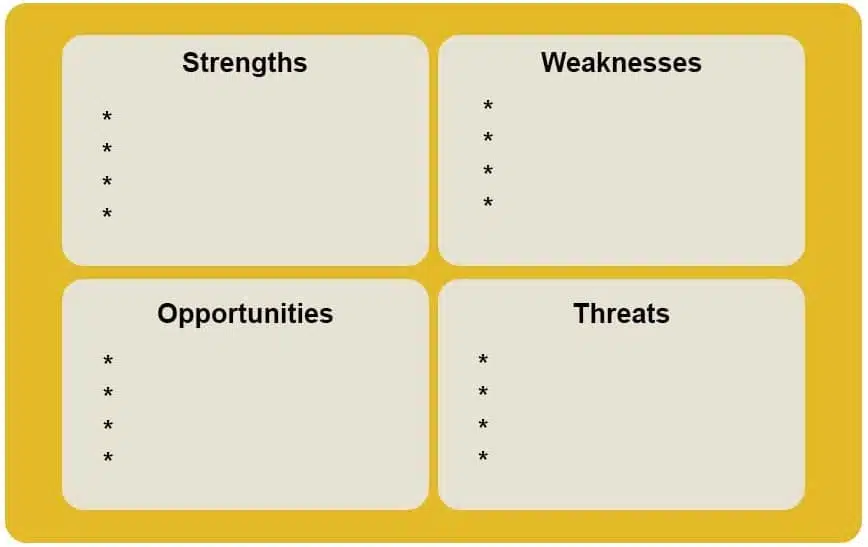
SWOT analysis is an essential management tool to evaluate a business’s strengths, weaknesses, opportunities, and threats. This framework identifies internal factors (strengths and weaknesses) and external factors (opportunities and threats) that can impact a business’s success.
Albert Humphrey, a consultant at the Stanford Research Institute, developed the SWOT analysis model in the 1960s. Originally developed as part of a research project to identify why corporate planning failed, Humphrey analyzed data from hundreds of companies and developed a framework to help identify the key internal and external factors affecting a business’s success.
Strengths, such as staff strength, a strong customer base, and a good brand, give an organization a competitive advantage. Weaknesses place an organization in a disadvantageous position, such as a low customer base or inexperienced staff.
When harnessed, opportunities are external factors that can provide promising returns or value, such as new markets or changing customer needs. Thomas Edison famously said, “Most people miss opportunity because it is dressed in overalls and looks like work.” Therefore, businesses must meet changing customer needs to gain customer loyalty and reap opportunity rewards.
Threats are negative external influences that can cause business trouble, such as dissatisfied employees, staff attrition, debt position, competitors, and new technology. By conducting a SWOT analysis, businesses can identify these threats and develop effective strategies to mitigate them.
What is the Environmental Analysis Process?
The business environmental analysis process requires the following steps:
- Define the Scope: Clarify the scope of the environmental analysis by identifying the specific business units, markets, and geographic areas that require analysis.
- Gather Information: Acquire relevant data and information from internal and external sources. Internal sources may include financial reports and performance metrics, while external sources may include market research reports, customer feedback, and industry trends.
- Evaluate Competitors: Assess the competitive landscape and determine whether any competitors pose a threat to the business. If so, conduct additional research to understand the competition better.
- Identify Internal Factors: Evaluate the business’s strengths and weaknesses, including its resources, capabilities, technological advancements, and operational processes.
- Identify External Factors: Assess the opportunities and threats presented by the external environment, such as market trends, regulatory changes, and competitive pressures.
- Analyze and Prioritize: Analyze the internal and external factors and prioritize them based on their potential impact on the business.
- Develop Strategies: Use the business’s strengths to achieve its goals and objectives.
- Monitor and Adjust: Regularly monitor the business’s performance and adjust strategies and processes as needed to ensure the business remains competitive and responsive to environmental changes.
The environmental analysis is an iterative process and requires continuous monitoring and adjustments to ensure the business alignment with the organizational goal.
Benefits of Environmental Analysis
- Identifies Opportunities and Threats: Environmental analysis enables businesses to identify opportunities and threats, reducing risks proactively and increasing profits.
- Provides Competitive Advantage: Environmental analysis gives businesses a competitive advantage by better understanding the market, consumer behavior, and competitors’ products and operations. This allows businesses to develop differentiated products and dominate the market.
- Improves Decision-Making: Environmental analysis provides decision-makers valuable data and information to make better-informed decisions.
- Optimizes Resource Utilization: By understanding market behavior and consumer preferences, businesses can invest their resources wisely, improving efficiency and optimizing resource utilization.
- Facilitates Strategy Formulation: Environmental analysis is a crucial tool in formulating effective business strategies, as it provides insight into market trends, consumer behavior, and competitors’ strengths and weaknesses.
Conclusion
Environmental analysis is a critical factor in achieving business success. By comprehending the market, competitors, consumer behavior, and other relevant factors, businesses can position themselves advantageously, capitalize on opportunities, and mitigate risks. This, in turn, can enhance profitability and drive long-term success.

I am Mohammad Fahad Usmani, B.E. PMP, PMI-RMP. I have been blogging on project management topics since 2011. To date, thousands of professionals have passed the PMP exam using my resources.

